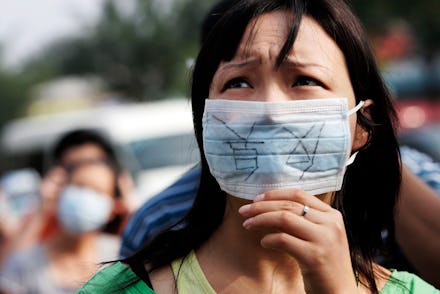There is an 8-Year-Old Girl With Lung Cancer, and China's Smog is to Blame

In the first case of its kind, an eight-year-old girl in China has become the youngest person in history to be diagnosed with lung cancer. Local doctors believe that China’s skyrocketing levels of air pollution are to blame. While rare, this case highlights the extreme degree to which China is undercutting its own economy and health with an outdated and inefficient growth model.
Every minute, there are six new cases of cancer in China, and every year there are two million related deaths a year. In 2010 alone, there were an estimated 1.2 million in premature deaths. These were largely due to air pollution, which is the largest environmental risk. Such loss of damage and cost to future economic activity is believed to have cost China $230 billion in 2010. Other examples of China’s pollution woes include a case from October of this year, when toxic smog forced the 11 million strong city of Harbin to shut down. The smog caused visibility to drop to ten meters, causing schools to cancel classes and airports to close. Such incidents are also alarming China’s neighbors as factories and power plants in China have caused increased acid rain to fall on Seoul and Tokyo.
Such telling statistics have been occasionally censored in certain official Chinese Communist Party (CCP) reports, since they could be damaging to the party’s reputation and growth strategy. China’s method of economic development is important because not only is it officially institutionalized, but also economic growth is what provides the legitimacy on which the CPP rests.
Over the last 30 years, the CCP’s shift from socialism to state capitalism has lifted over 500 million Chinese out of poverty. In the late 1980s, Deng Xiaoping created a new incentive system in which provincial and local officials are judged and promoted based on two criteria: continual economic growth in their jurisdiction and suppressing dissent. Central plans for economic growth and tight competition to be promoted resulted in local officials trying to outdo their peers’ growth in provincial and city GDPs.
In rural China, land is still collectivized and peasants lease the land and are without private property rights. Because of this, local official often seize their land for development, providing little compensation while selling the land at high rates to private or, more often, state-run companies.
These perverted incentives also cause officials to support or turn a blind eye to projects that are less energy or cost efficient, but boost short-term GDP and are quick to complete. Examples of this include little to no insulation in most new buildings and the use of long outdated turbine technology in power plants.
The result has been soaring economic growth fueled by an artificial stimulus of land and house prices without great concern for future growth, the environment, or local dissent. Real estate, housing, development, and their related industries now account for about a third of China’s economy and real concerns have emerged that the CCP’s political incentives are creating a housing bubble on the scale of America’s infamous 2008 one.
Putting this another way, imagine for a moment if American governors and mayors were judged over how much economic growth they could create and that they were given free use of imminent domain to achieve such growth. They could send the policy to seize as much land to give to Walmart or General Motors as they’d like and all they have to do was provide a meager penance as compensation. That is the source of China’s environmental and future economic woes; citizens have no legal recourse and politicians have no incentive to think in the long term.
China’s Ministry of Environmental Protection is also very weak. In fact, state owned companies block or ignore regulations on a regular basis. Also, half-hearted efforts by President Hu Jintao to include a "Green GDP" into the evaluations of local officials has made no difference. Initially designed to take into account the cost of pollution, the measure was scrapped because of the many of the new growth calculations were close to zero in several provinces.
While environmental degradation as a side effect of the industrialization is the norm throughout history, and arguably nearly impossible to avoid, there is no comparison to China’s juggernaut. Never before has a state had economic growth and environmental problems on such a massive scale, and thus there is no previous case to go by. And so far, China has made some progress but the results are mixed and the long-term outcome uncertain.
On one hand, China has undertaken a $200 billion green and nuclear energy initiative and has begun experimenting with cap and trade as theoretical solutions in some special zones. Also despite how bad things are, most of China’s cities are "no more polluted than Japan’s were in 1960 … [and] air quality is improving at about the same rate as Japan’s did in the 1970s."
Yet at the same time, many other parts of China’s environment are much worse, such as the Yellow River in the north, which serves 50% of all Chinese and irrigates 60% of all farmland, and is in grave overuse. Pollution has also caused almost 500 million Chinese to be without access to safe drinking water.
Thus, it is difficult to tell what lies in China’s environmental future and whether Beijing is unable or unwilling to change its top-down incentives for short-term growth despite the cost.
Either way, China’s top-heavy model of growth is due for an overhaul.